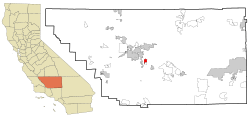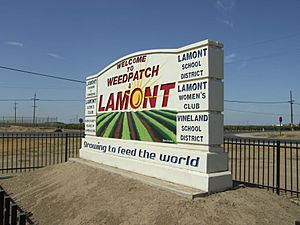Lamont, California facts for kids
Quick facts for kids
Lamont
|
|
|---|---|

Location of Lamont, California
|
|
| Country | |
| State | |
| County | Kern |
| Area | |
| • Total | 4.626 sq mi (11.980 km2) |
| • Land | 4.590 sq mi (11.888 km2) |
| • Water | 0.036 sq mi (0.092 km2) 0.77% |
| Elevation | 404 ft (123 m) |
| Population
(2020)
|
|
| • Total | 14,049 |
| • Density | 3,037.0/sq mi (1,172.70/km2) |
| Time zone | UTC-8 (PST) |
| • Summer (DST) | UTC-7 (PDT) |
| ZIP code |
93241
|
| Area code(s) | 661 |
| FIPS code | 06-40088 |
| GNIS feature ID | 1660886 |

Lamont is a community in Kern County, California, United States. It's known as a census-designated place (CDP). This means it's a special area defined by the government for counting people. Lamont is located about 9 miles (14 km) south of downtown Bakersfield. It sits at an elevation of 404 feet (123 meters) above sea level. In 2010, about 15,120 people lived there.
Contents
Where is Lamont Located?
Lamont is found in the southern part of California. It's about 11 miles (18 km) from Bakersfield. Los Angeles is about 89 miles (143 km) away.
The community covers a total area of about 4.6 square miles (12 square kilometers). Most of this area is land. A very small part, about 0.04 square miles (0.1 square kilometers), is covered by water.
The History of Lamont
Lamont was officially started in 1923.
Early Growth and the Great Depression
During the 1930s and 1950s, many farm workers moved to the Lamont area. They came from the eastern parts of the United States. They were looking for a better life during tough times. These times included the Great Depression and the Dust Bowl. The Dust Bowl was a period when severe dust storms damaged farms. The first post office in Lamont opened in 1947.
Lamont's Public Library Story
The first public library in Lamont opened in June 1912. It was in the home of Phoebe Wells in nearby Weedpatch. The Lamont area grew quickly. Many workers came for jobs in the oil industry. Because of this growth, the library moved to a new building in 1935.
In 1952, the local government bought land to build a new facility. This building would hold both the library and a public health center. It opened in January 1953. The library stayed there until January 1974. Then it moved to an even newer and larger place. Five years later, it moved again to the former Lamont Community Building.
To meet the needs of a growing population, a brand new library was built. Funds for this came from the California State Library and other government programs. The old building was taken down. The new library opened to the public in the spring of 1998.
Who Lives in Lamont?
| Historical population | |||
|---|---|---|---|
| Census | Pop. | %± | |
| U.S. Decennial Census | |||
Lamont's Population in 2010
The 2010 United States Census counted 15,120 people living in Lamont. The community is quite diverse. Many residents are of Hispanic or Latino background, making up about 94.5% of the population.
The census also showed that about 35.8% of the people were under 18 years old. About 5.4% were 65 years or older. The average age in Lamont was 24.7 years.
Lamont's Population in 2000
In the census of 2000, there were 13,296 people living in Lamont. About 88.85% of the population was Hispanic or Latino.
About 38.6% of the people were under 18 years old. About 5.5% were 65 years or older. The average age was 24 years.
Education in Lamont
Lamont has its own school district called the Lamont School District. This district includes:
- Lamont Elementary School
- Alicante Avenue School
- Myrtle Avenue School
- Mountain View Middle School
Older students attend schools in the Kern High School District. This district includes Nueva High School in Lamont.
Local News
The Lamont Reporter is the local newspaper. It comes out every week.
Community Events
Every December, the community of Lamont celebrates the holiday season. The Lamont Chamber of Commerce hosts a parade down Main Street. It's a fun way to kick off the holidays!
See also
 In Spanish: Lamont (California) para niños
In Spanish: Lamont (California) para niños


